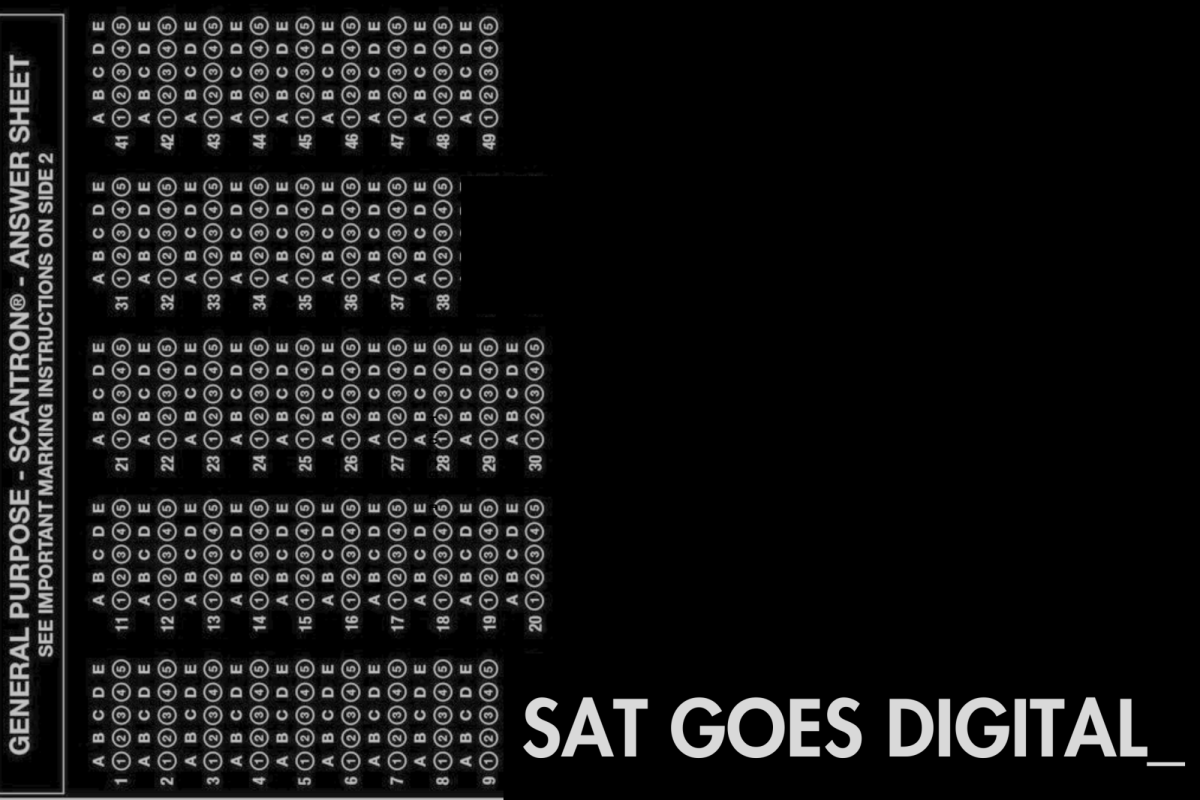In March, students across the country took the very first Digital Scholastic Aptitude Test (SAT). This was the first time the exam was administered online, and it wasn’t what students were expecting…at all.
Historically, the SAT, an exam that may account for a part of a student’s college application, has been taken on paper. However, the College Board recently switched the exam format to digital, citing their goal to “provide a testing experience that is more relevant to today’s students and less stressful.” Yet, when several students left the exam hall on Saturday, March 9, their emotions could only be described as stressed, frustrated and puzzled.
Students may have thought that the newly introduced digital SAT would be similar to the familiar, on-paper SAT. Those students couldn’t have been more wrong. In terms of scoring, formatting and frankly the entire test, the digital SAT differs massively from the on-paper SAT.
To start, the digital SAT is more than 45 minutes shorter than its on-paper counterpart. Instead of the old 154 questions, the new SAT features only 98 questions, 56 questions fewer.
The new exam covers “Math” and “Reading and Writing,” and divides the material into two sections, with two adaptive modules in each. For both sections, Module 1 contains easy, medium and hard questions, and serves as an indicator to a student’s ability. Module 2 then contains either harder or easier questions, depending on how the student scored in Module 1. If a student performs well on the first module of Reading and Writing, the test “adapts,” and their second module is relatively more difficult. If a student does not do well on the first module in a specific subject, the test will “adapt” and give the student easier questions in the second module. However, there is a glaring issue: we don’t know what exactly “doing well” means.
Before this new format, taking the exam was pretty straightforward. Everyone got the same version, and students would just take the test and try to get as many questions right as they could. The more questions they got right, the higher their score. However, with the implementation of adaptive testing, achieving a higher score goes much further than just answering questions correctly.
How many questions must a student answer correctly to receive the more difficult second module? If a student receives the easier module, how high can they score on the entire subject? Furthermore, if a student receives the easier module and does well on it, is it possible for them to get a higher score than a student who receives the harder module and does poorly? These are all important questions that the new adaptive test format raises, and ones that the College Board fails to answer, leaving students without vital information that can help them determine how to approach taking the test.
On the official website in a blog titled “Everything You Need to Know About the Digital SAT,” the College Board claims that they took the opportunity to “make the SAT a far better experience for [students].” In the same blog, instead of explaining one of the most important changes in the SAT, adaptive testing, they instead provide a link to a different blog… Ironic since the previous blog is titled “Everything You Need to Know About the Digital SAT.”
The new blog that students are navigated to then goes on to elaborate “Depending on how you answer the questions in the first module, you’ll be routed to a second module, which has a different mix of difficulty levels. The mix of questions in the second module is, on average, either of higher difficulty or of lower difficulty than that in the first module.” This vague explanation doesn’t provide any sort of insight on the number of correct answers required to advance to a more difficult module two.
To make matters worse, the “Everything You Need to Know About the Digital SAT” blog, the separate blog it links and the multitude of nearly identical informational Digital SAT websites that college board offers all fail to answer how students with harder Module 2 questions will be scored compared to students with easier Module 2 questions.
We don’t count the sorry excuse of an explanation that is listed on the adaptive testing blog. They say “Your score will be accurate, and you won’t get a lower score just because you saw a lower difficulty set of questions.” Does that mean that a student who receives an easier Module 2 can score the same as a student who receives a harder Module 2? If so, then do the benefits of having potential for a higher score in a harder module outweigh the risks of scoring poorly on those difficult questions?
The College Board fails to offer a clear explanation to so many questions. It is outrageous and, frankly, it is embarrassing that an organization as large as the College Board can fail to clarify one of the largest changes they’ve implemented, ever. And, while the ambiguity of this test remains, its effects go deeper than one might expect. Many students are using their SAT scores when applying to colleges, and they need to understand what they’re getting themselves into.
The College Board views this new format as beneficial to students, and maybe they’re right and we just don’t know it yet. However, the timing of administering this new exam format wasn’t very convenient. The first digital exam occurred this past March. Many high school juniors take the exam during this time, as they can spend their junior year preparing for it, and check it off of their list before studying for AP exams and starting college applications. However, the surprising difficulty of the test could mean that these students have to spend additional time preparing for the exam when they already have enough to keep themselves busy.
Additionally, many top universities in the country are rolling back their test-optional policies. Harvard University just recently announced that students in the high school class of 2025 must submit test scores. In the next few years, some schools will require students to submit their SAT or American College Test (ACT) scores. As the importance of standardized test scores return, it is extremely important that students know everything about the exams they are taking.
Taking standardized tests, and the college application process in general, can be stressful for students. Their performance on their standardized tests, grades, extracurricular activities and so much more can determine the course of their lives. The College Board should, at the very least, provide more information about the new SAT so that students can prepare adequately for the exam and do the best they can, in a fair way.





![Last Wednesday, the Wayland School Committee gathered to discuss a number of topics regarding the health curriculum and Innovation Career Pathway course. Another large topic of conversation was the ways to potentially mitigate distracting cell phone usage. "These [phones] are going to distract your learning and social relationships," Superintendent David Fleishman said. "That's concrete right there."](https://waylandstudentpress.com/wp-content/uploads/2025/06/Screenshot-2025-06-04-at-9.49.31 PM-1200x886.png)



























Test Prep Gurus • May 6, 2024 at 3:32 PM
Excellent questions!
“Does that mean that a student who receives an easier Module 2 can score the same as a student who receives a harder Module 2?”
The short answer is: No.
For example, you cannot score an 800 on the verbal or math without reaching the more difficult module 2.
There is a video on YouTube that offers a clearer explanation than the one on the College Board website as to how the adaptive scoring works.
Search for “New Digital PSAT and SAT White Board Drawing” on YouTube.